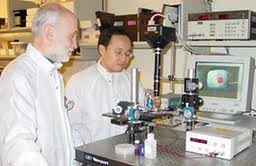A breakthrough in a University of Cincinnati engineering lab that could clear the way for a low-cost, even disposable, e-reader is gaining considerable attention and this technology could have ‘far-reaching’ implications and provide all sorts of opportunities in the field of packaging, with the ability to ‘print’ moving pictures (of a quality seen on glass) onto flexible packaging.
Electrical Engineering Professor Andrew Steckl, together with UC doctoral student Duk Young Kim, have researched into an affordable, yet high-performance, paper-based display technology which has demonstrated that paper could be used as a flexible host material for an ‘electrowetting’ device. Electrowetting (EW) involves applying an electric field to coloured droplets within a display in order to reveal content such as type, photographs and video.
Steckl’s discovery that paper could be used as the host material has far-reaching implications considering other popular e-readers on the market such as the Kindle and iPad rely on complex circuitry printed over a rigid glass substrate. Steckl says: “It is pretty exciting. With the right paper, the right process and the right device fabrication technique, you can get results that are as good as you would get on glass, and our results are good enough for a video-style e-reader.”
He imagines a future device that is “rollable, feels like paper yet delivers books, news and even high-resolution color video in bright-light conditions” – perfect for packaging applications (in my opinion)! If you combine this with the Sony technology (Rollable OTFT screen) that we wrote about recently, the packaging possibilities are endless!
Read more about this type of technology in our ‘Technology’ folder.
You can read the full Steckl article at www.nanowerk.com
Chris Penfold

